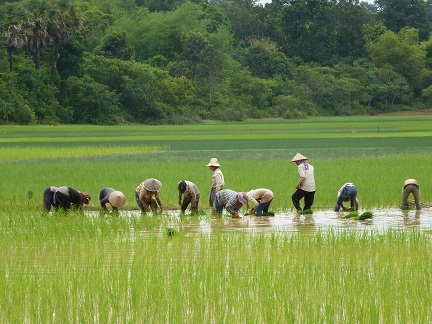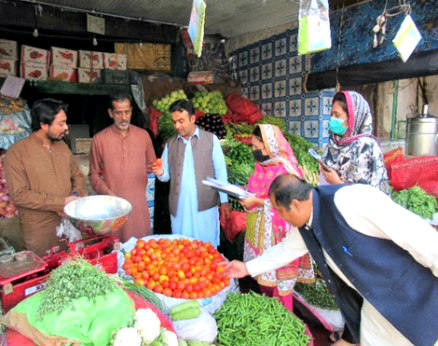At the second Greater Mekong Subregion Agriculture Ministers Meeting, which opened yesterday in Siem Reap province in Cambodia, ministers from the six GMS countries – Cambodia, China, Laos, Myanmar, Thailand and Vietnam – are discussing the most important issues in agricultural sectors of the sub-region. The main topics in the meeting focus on increasing productivity in the agriculture sectors of the sub-region countries and also potential markets for agricultural products, and included in this is developing agrotourism. Linkages between agriculture and tourism can be beneficial to both industries, and tourism is also seen as a way of boosting rural employment and economies. CABI, which is involved in both agricultural and tourism development, is represented at the event by Dr Qiaoqiao Zhang, Memberships Director & Secretary to CABI Executive Council.
Hean Vanhan, director-general of the Agriculture Ministry’s general directorate of agriculture, says that while it is important for Cambodia’s agricultural production to increase, at the moment there are limited markets to export to.
“China, which is a member of the GMS, is one of the biggest markets, and while our agricultural production is increasing, we can explore new markets and hopefully find new partners in the meeting,” Mr Vanhan said, quoted in the Khmer Times.
As well as a training workshop and dialogue with relevant parties and international institutes, agro-food products and agro-tourism products are being displayed at the event. Mr Vanhan said that Siem Reap was chosen to host the meeting because Cambodia wants to link agricultural development with the tourism sector. The Mekong Tourism Office posted an invitation to tour operators, hoteliers, airlines, restaurants and retailers to attend the event, and the Mekong Tourism website states that tour operators “recognise they must deliver a travel experience that is active rather than offering passive sightseeing” and that “even the Chinese travel market”, one of the most important source markets for the Mekong region, is now providing itineraries that explore culture and offer rural activities linked to agriculture.
Greater linkages between the two industries are mutually beneficial. Food and gastronomic tourism is a growing tourism niche, and regional food is one of the leading motivations for why many people travel to a particular destination. In the Forward to the 2nd Global Report on Gastronomy Tourism issued by the UNWTO in May this year, UNWTO Secretary-General Taleb Rifai says that gastronomy tourism “offers enormous potential in stimulating local, regional and national economies and enhancing sustainability and inclusion. It contributes positively to many levels of the tourism value chain, such as agriculture and local food manufacturing.”
Hotels, restaurants and resorts can become an important market for local food producers, but all too often tourism businesses – particularly larger hotels and resorts, often foreign-owned – instead import much of the food and drink they supply to guests. This contributes to the “leakage” that often means that much of the revenue from international tourism is lost to the destination, instead going to foreign tour companies, hotel chains, and suppliers of goods and services including food and drink.
For local food producers to become part of the tourism supply chain, they need to be able to offer produce of high and consistent quality, be able to guarantee supply whenever required, and in the quantities needed. This may need training, or for groups of small producers to work together to ensure reliable supplies. While some forward-thinking hotels and restaurants are prepared to work with local producers to help the farmers supply their demands, in other cases it may need public-private sector cooperation, with agricultural agencies helping to provide training to producers, or facilitating producers coming together in cooperatives. This may be particularly important in countries where there are a high proportion of small farmers, who possess neither the scale to give regular supplies of produce, or the marketing expertise to access the tourism supply chain. The UNWTO report says that public-private collaboration is an essential instrument of co-operation for the development of gastronomy tourism, and this also applies to creating wider linkages between food producers and tourism businesses.
Searching CABI’s Leisure Tourism database, I found a paper from Siem Reap in Cambodia, in which Mao et al. (2014) investigated agriculture and tourism linkages in the region, exploring whether local farmers have benefitted from the influx of tourists. The authors report that market, institutional and supply driven constraints encountered by local farmers in gaining entry to the tourism market are similar to those faced by farmers in other developing countries. The inability of farmers to supply the tourism market was found to be a function of both demand and supply factors, the latter mainly structural.
Among the findings of the study was that very few local residents around Siem Reap raise fish, with no-one producing lobsters and shrimps which are used in many restaurants. The number of livestock raised in all communes in this district was insufficient to meet the demand of the tourism sector. High volumes of fruits, including durian, rambutan, mangosteen, apple, coconut and mango, are also imported, especially from Thailand and Vietnam. The paper quotes a figure saying that an estimated $400 million of Cambodia's $2 billion tourism income in 2012 flowed out of Cambodia, to fund agricultural imports. Market access constraints include lack of market information, inability to compete against imports, poor connections between farmers and the tourism sector, no initiatives from the tourism sector to establish linkages, and low prices. While some of these constraints require action from the tourism sector, farmers can be helped to address production constraints such as storage problems, poor technical knowledge, and lack of quality crop varieties and animal breeds, by a combination of training and assistance to access improved seeds and livestock.
The same issues occur in other parts of the world. In 2014, a forum in Grenada in the Caribbean discussed how to make small-scale agriculture more competitive, bringing together representatives of the public and private sectors, producers’ organizations, financial institutions and international cooperation agencies to look at the potential of agrotourism. Ena Harvey, Inter-American Institute for Cooperation on Agriculture (IICA) representative for Barbados, suggested that certified products with value added are the key to a demanding market that looks for high-quality food, while at the same time strengthening the local and regional markets that serve the tourism sector. Thomas-Francois (2017) examined food value chains in Grenada and suggests that there are opportunities for tourism policies that foster local food linkages with high-end accommodation properties as a strategy to spread the economic spin off from tourism. Also in the Caribbean, Jamaican Tourism Minister Edmund Bartlett has urged local agricultural suppliers to meet the needs of tourism businesses and help reduce the island’s import bill.
Covering the global literature in both agriculture and tourism, CABI’s databases including CAB Abstracts and the subject-focused Leisure Tourism are the best place to find research on agrotourism and linkages between these two vital industries. We also publish a number of relevant books, including a 2009 book on Agritourism, and a 2015 book on marketing in food tourism. A recently published title on Linking urban and rural tourism addresses topics such as using rural agricultural products in urban tourism experiences, and designing food and drink trails.
CABI of course is also heavily involved in agricultural development, with a particular focus on small farmers in developing countries, helping them to ‘grow more and lose less’ by providing information and applying expertise, and through innovative programmes such as Plantwise which establishes networks of local plant clinics, run by trained plant doctors, where farmers can find practical plant health advice. Our Regional Consulations with member countries have also identified providing information and training resources to support sustainable agro-tourism and other non-farm rural employment as a priority need, and we are working towards an offering of tourism training via e-learning.
After the Mekong meeting, Dr Zhang will also next week be attending the upcoming General Assembly of the United Nations World Tourism Organization in Chengdu, China, where the major focus will be how tourism can contribute towards the Sustainable Development Goals.
Further reading
- UNCTAD, 2015, Enhancing linkages between tourism and the sustainable agriculture sectors in the United Republic of Tanzania, pp. viii + 50 pp. (Access PDF)
- Mao, N., Grunfeld, H., DeLacy, T., Chandler, D., 2014, Agriculture and tourism linkage constraints in the Siem Reap-Angkor region of Cambodia., Tourism Geographies, Vol. 16, No. 4, pp. 669-686 http://dx.doi.org/10.1080/14616688.2014.915878
- Thomas-Francois, K., Massow, M. von, Joppe, M., 2017, Service-oriented, sustainable, local food value chain – a case study., Annals of Tourism Research, Vol. 65, pp. 83-96 https://doi.org/10.1016/j.annals.2017.05.008
Related News & Blogs
Strengthening the potato value chain in the Kurdistan Region of Iraq
On 30th May, we marked the International Day of Potato. In this blog, CABI’s Crop Health Advisor Anna Wood provides an update on a five-year project led by CABI to strengthen the potato value chain in the Kurdistan Region of Iraq. An ambitious five-yea…
3 June 2025





